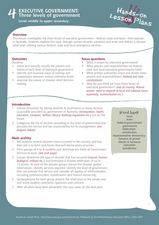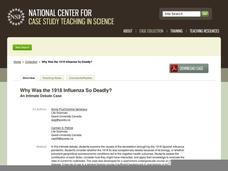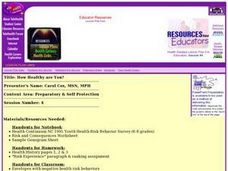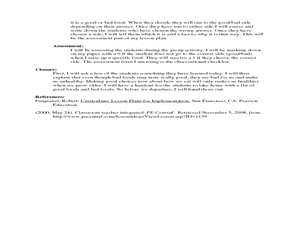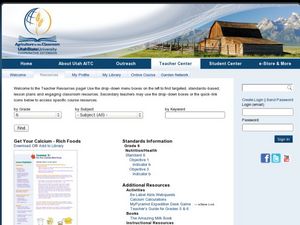Curated OER
Fracking: Positive or Negative Impact?
Your teenagers may have heard of fracking, but do they really know what it is? And could they debate the benefits and risks? Educate your environmental science class with a lesson about hydraulic fracturing, non-renewable energy sources,...
NOAA
Marine Ecosystems
Be at the top of the food chain when it comes to understanding marine ecosystems. The 21st installment of a 23-part NOAA Enrichment in Marine sciences and Oceanography (NEMO) program investigates marine ecosystems, ocean zones, and food...
Curated OER
Space Age Technology Comes to Earth
Both GPS and GIS are now used regularly in agricultural careers. Explore the new technologies that require higher education for those interested in agri-science careers. Upper graders examine how agriculturalists use new technologies by...
Curated OER
Key Ingredients: America by Food
Students participate in a series of activities to explore the types of food Americans eat, how food choices differ in various parts of the country, and how the availability of various foods has changed over time.
Curated OER
Key Ingredients: America By Food
In this set of five lessons, students analyze the important of food traditions, identity, and history. Students analyze how food traditions contribute to family identity, investigate family food traditions through interviews, and compare...
Curated OER
What's Your Agricultural Experience?
Consider sharing information about a fast growing career cluster with your class. They'll discuss the careers and higher education associated with agricultural careers. A worksheet, web links, and video links make exploring the world of...
Curated OER
Executive Government: Three Levels of Government
Students identify and classify the powers and responsibilities of all three levels of executive government in Australia. In this executive government lesson, students discuss the various services that the government in Australia...
National Center for Case Study Teaching in Science
Why Was the 1918 Influenza So Deadly?
Which factor was more influential in the 1918 flu epidemic: biology, or social and political conditions? Your AP biology class will research and debate one of these positions in an interesting and challenging lesson. Intended for...
Curated OER
Final Project Presentations: Water Quality
Learners synthesize the information they have been researching on water quality to evaluate the potential health risks in a region with arsenic contamination. They prepare and present a persuasive speech that incorporates visuals.
Curated OER
Alaska Natives and Health
Students explore the Maniilaq web site to explore how one organization in Alaska has created a health care system following the 1975 American Indian Self-Determination Act.
Curated OER
How Healthy are You?
Students determine how healthy they are. They examine health risk behaviors of adolescents and their consequences. They complete a risk factor survey and discuss why they might take risks.
Curated OER
Gymnastics Lesson
Learners investigate the importance of having a healthy body by performing gymnastics. In this physical education lesson, students utilize their flexibility and body strength to perform intense physical gymnastic maneuvers with the help...
Curated OER
Message in a Bottle
Learners consider the implications of the misuse of alcohol. In this personal health lesson, students visit selected websites to discover information about the misuse of alcohol and examine advertisements for alcohol.
Curated OER
Vital Signs
Students research health-related topics such as good nutrition, exercise, and the human body. They analyze their data and distribute it through the use of the Internet.
Curated OER
Introduction To Wellness
Students investigate the affects of various risk factors and cumulative risk factors vs. a life of wellness in this technology-based lesson for the High School Health class. The lesson requires the use of the Inspiration education...
Curated OER
Diet and Exercise Activity
Students explore their physical abilities by participating in team sports. In this physical education lesson, students collaborate in groups in one of several team sports before moving on to the next station. Students discuss healthy...
Curated OER
Quit Smoking-Together We Can Do It!
Students explore how tobacco threatens the health of smokers and non-smokers. They research smoking and second hand smoke using the Internet. Students create a Quit Smoking brochure. They present a computer slide show to describe how...
Curated OER
Exploding Cheeseburger
Second graders describe the components of a healthy diet. In this nutrition and health lesson, 2nd graders identify the importance in eating a variety of healthy food. Students explain what makes a healthy diet.
Curated OER
the Business of Good Ideas
Students consider economic factors in patenting a new invention. They research an already-patented health product and assess its profitability.
Curated OER
Staying Healthy
In this health worksheet, 5th graders read the paper that is about the nutrition needed. They focus upon the guidelines set for dietary allowances.
Curated OER
Comparing the Food Choices and Body Image of 15-Year-Olds Around the World
Students interpret data regarding food choices and the perceived body image of youth in the world. In this personal health lesson, students compare food consumption patterns in Canada with other countries. Students also compare lifestyle...
Curated OER
Build a Burger
Second graders describe a balanced diet. In this nutrition and health lesson, 2nd graders use a hamburger to exemplify the different food groups necessary for a blanaced diet. Students use the food pyramid as a resource.
Curated OER
Calorie Countdown
Fifth graders analyze their caloric intake and energy output. In this nutrition and health lesson, 5th graders use the Dietary Guidelines for Americans to evaluate their personal food intake and activity level. Students explore the...
Curated OER
Get Your Calcium - Rich Foods
Fifth graders explore personal health by identifying positive food choices. In this calcium sources lesson plan, 5th graders discuss the common ways a human can receive calcium such as consuming dairy products. Students view a virtual...








